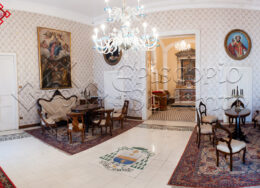Sorrento Cathedral
The Cathedral of the Archdiocese of Sorrento-Castellammare di Stabia is located in the city of Sorrento. In addition to the Assumption of the Virgin into Heaven, it is dedicated to the Holy Apostles Philip and James the Less. This temple already existed in the 11th century, as various documents attest
It has continually undergone profound and radical changes at the behest of its shepherds. Today it is admired by all for its beauty and the balanced elegance of its Baroque style. You can admire, among the many works, a sixteenth-century archbishop’s throne in selected marbles, canvases by artists of the Neapolitan school of the 18th century and various Sorrento inlay works created by talented local artists.

Archbishop’s Palace
The sixteenth-century archbishop’s palace has two floors: the access is located inside the courtyard of the cathedral of Sorrento. After passing the wooden entrance door, you enter the staircase that leads to the first floor where the historic apartment is located and to the upper floor where the offices of the archiepiscopal Curia are located.
In the historic apartment you can admire works dating from the 1600s to the 1900s. Of particular relevance is the San Tommaso room which preserves in the upper part of the walls, a cycle of frescoes dating back to the end of the 16th century depicting a Eucharistic procession.
The bell tower of the Cathedral is incorporated into the building: with a square plan and divided into five orders, it must have originally been in the Romanesque style, but then remodeled in the 18th century.
Church of San Francesco
The church of San Francesco dates back to the 16th century. The main altar is surmounted by a throne supported by two columns with a large canvas in the center depicting St. Francis receiving the stigmata surrounded by angels (by Attilio Gamba and dated 1735).
In the first chapel, entering on the right, there is the beautiful and expressive wooden statue of St. Francis with the crucified Christ, donated by the noble Vulcano family in 1663.
Cloister of San Francesco
Next to the church, through a small door, you enter the splendid fourteenth-century cloister. The architecture of the cloister has crossed tuff arches on two sides of the portico, a typical stylistic expression of the late fourteenth century, replaced on the other two sides by round arches on octagonal pillars remodeled in 1447.
Furthermore, the presence of various elements from pagan temples should be noted, such as the three functionally reused corner columns.
Church of Santa Maria delle Grazie
The Church of the Dominican monastery of Santa Maria delle Grazie, which is accessed through a majestic sixteenth-century portal in finely decorated Vesuvius stone, is from a pictorial point of view an interesting anthology of southern art created between the end of the sixteenth century and the beginning of the XVIII.
On the altar you can admire the polyptych made in 1582 by Silvestro Buono. The central panel depicts the Madonna delle Grazie with Child in her arms between St. John the Baptist, St. Dominic and the founder of the monastery, the Sorrento noble Berardina Donnorso.
Church of the Servants of Mary
The Church, located behind the Cathedral, is the seat of the Venerable Confraternity of the Servants of Mary and of the Archconfraternity of San Catello and Death. The construction, begun in 1761 and completed in 1778, has a single nave and is accessed via a marble staircase with two arms. Inside, in addition to several canvases by Carlo Amalfi, a renowned painter of the Bourbon court, there are an expressive wooden statue of the dead Christ, by an unknown author, and of Our Lady of Sorrows which on Good Friday are carried in procession by the brothers, hooded of black. In the corridor leading to the sacristy there are many French paintings, majolica, documents and geographical maps from the 1700s as well as various furnishings. In the following rooms are the books of the ancient library of the Franciscans, with manuscripts from the 1400s and interesting volumes ranging from 1500 to 1800.

















